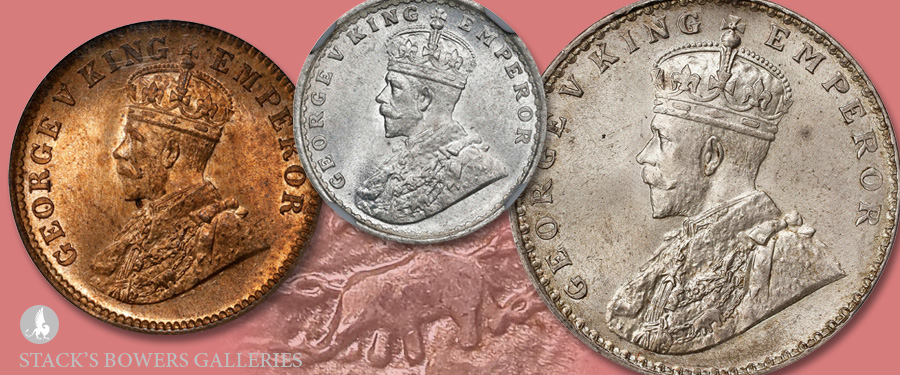
As King George V ascended to the throne in 1911, the Royal Mint prepared dies depicting the new sovereign to strike coins for use across the world. The elephant featured on the collar of the most eminent order of the Indian Empire worn on the robe of the king sparked controversy; the animal, as depicted, resembles a pig. Many of the coins were withdrawn and unissued stocks were destroyed. This controversy lends the distinctive one-year subtype its name: the “Pig Rupee.”
The new coins were struck at Bombay and Calcutta and slated for release on December 12, 1911, Durbar Day, when George V was declared Emperor of India. The elephant on George V’s collar lacked detail, with ears barely visible and the trunk and face not well defined. Consumers and other observers were quick to note the animal’s “porcine” qualities. The March 1912 issue of The Numismatic Circular and Catalogue of Coins, Tokens, Commemorative & War Medals, Books & Cabinets, published by the London-based Spink & Son, sums up the controversy and its causes: “As soon as the coin was issued it was universally criticised, and no amount of explanation has been able to do away with the fact that the elephant on the King’s chain presents to the naked eye a decidedly porcine appearance.”
The article quotes a local newspaper, which snarked: “It would appear that knowledge of natural history is somewhat lacking among the draughtsmen responsible for designing coinage in London.” The paper further surmised “The similarity must be something more than imaginary to induce the authorities to withdraw the coin from circulation when several lakhs of it have already been issued. It has been left to the designers of the British Mint to suggest a resemblance between the degraded and reviled swine and the grand giant which plays so proud a part in Oriental pageantry.”
It had been hoped that the new coins might remedy a different issue with British Indian coinage. A different article in the same issue of The Numismatic Circular explained reaction to the coins of George V’s predecessor, Edward VII: “His majesty [Edward] is represented wearing the imperial Crown, a most important point when the reception which the previous rupee met with is considered. The King-Emperor Edward the Seventh was, unfortunately, depicted in the classical manner, the bare head and neck only, being shown on the obverse of the coin, much to the surprise of the majority of his Indian subjects. These, naturally, demanded some outward symbol of royalty; and the absence of this, led the rupee to be designated ‘the naked head’. This has been successfully rectified in the recent issue.”
One step forward, one step back.
The authorities ordered the coins recalled on January 23, 1912. According to a March 2023 article on Professional Coin Grading Service’s website, some 700,000 of the coins had already been issued. The remainder, and all coins recovered from circulation, were melted. Dies were modified with an updated portrait and the coins continued to be struck with this bust through the end of George V’s reign in 1936.





